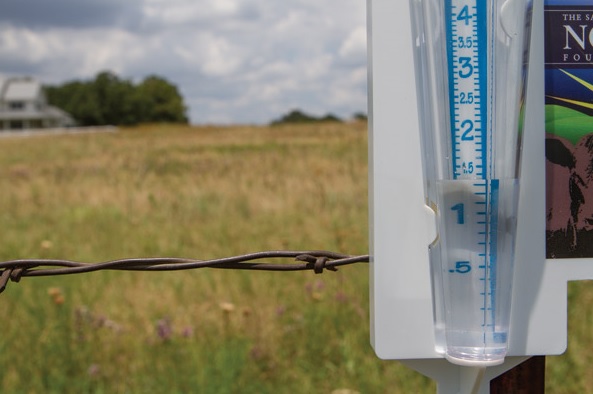
Agricultural News
Noble Foundation Offers Techniques to Conserve Water Resources
Mon, 15 Jun 2015 20:23:44 CDT
 Jim Johnson, Samuel Roberts Noble Foundation Soils and Crops Consultant
Jim Johnson, Samuel Roberts Noble Foundation Soils and Crops Consultant
In April 2014, I wrote about some issues facing our water resources (Water resources serve agriculture, energy, society). In this article, I will address a few ways to better steward our water resources.
On any landscape, there are opportunities to reduce the amount of water evaporated from the soil. One option for grazers is to leave the grazed stubble a little taller so it shades the soil a little more. For instance, if you normally graze to a 4-inch stubble height, try grazing to a 5-inch stubble height. You may give up a small amount of production, but you will gain a little more shade on the soil surface. Increasing shade on the soil surface reduces the temperature of the soil on a hot, sunny day, and in turn, reduces the amount of water lost to evaporation from the soil. The same holds true when mowing the lawn or cutting hay. Raising the cutting height by a small amount will allow your yard or hay meadow to evaporate less water and redirect that water to growing grass.
The design of a pond to supply livestock water can also conserve water. A deeper pond with a smaller surface area is better than a shallow pond with a larger surface area. The bigger the surface area, regardless of the depth, the more evaporation can occur from the pond. For example, if the surface of a pond loses 1 inch of water over the course of three summer days, you would lose 1 acre-inch of water from a pond with 1 surface acre; you would lose 2 acre-inches of water from a pond with 2 surface acres. If the 1-acre pond is 20 feet deep and the 2-acre pond is 10 feet deep, they have the same storage capacity. However, the deeper pond with the smaller surface area will lose less water to evaporation.
Plants growing in soils with adequate fertility are more water efficient and make more forage or crop per inch of water used. Grazers and crop farmers should both maintain soil nitrogen, phosphorus, potassium and pH at adequate levels.
Another way crop farmers can reduce evaporative losses from soil is by reducing tillage and leaving more crop residue to cover the soil. Again, the shading of the soil surface by crop residue reduces the temperature of the soil surface, which again reduces the amount of water lost due to evaporation.
Farmers with irrigation can more efficiently use the water they apply by irrigating less frequently but with larger irrigation amounts that allow water to soak more deeply into the soil. In the Southern Great Plains, it is possible to lose one-quarter of an inch of water from each irrigation application to evaporation of the water droplets before they reach the ground. This means that if only one-half of an inch of water is applied at a time, one-half of the total application is lost. If two one-half inch applications are made in an attempt to apply one inch of water, only one-half inch of the total gets used and the other half inch is lost. However, if 1 inch is applied in a single application and one-quarter of an inch is lost, then three-quarters of the inch applied are used.
These are just a few ways that we in agriculture can make more efficient use of the water we have. Hopefully, these techniques and others will allow us to make the most efficient use of our water resulting in better stewardship of our resources.
WebReadyTM Powered by WireReady® NSI
Top Agricultural News
More Headlines...



















